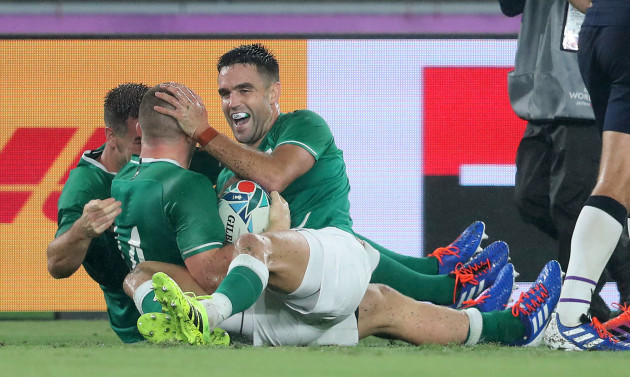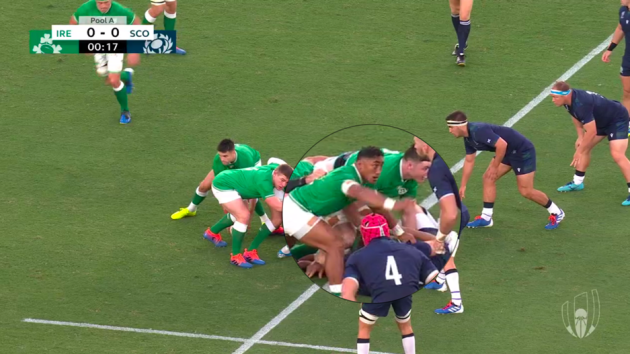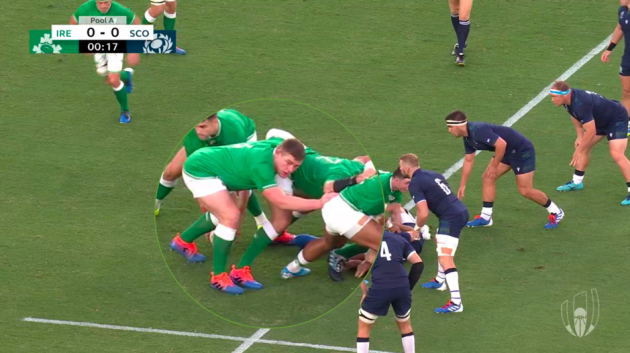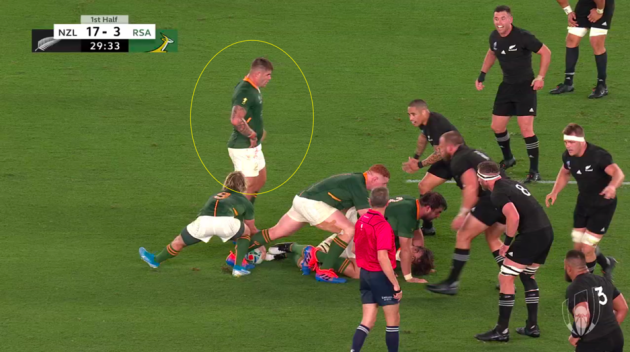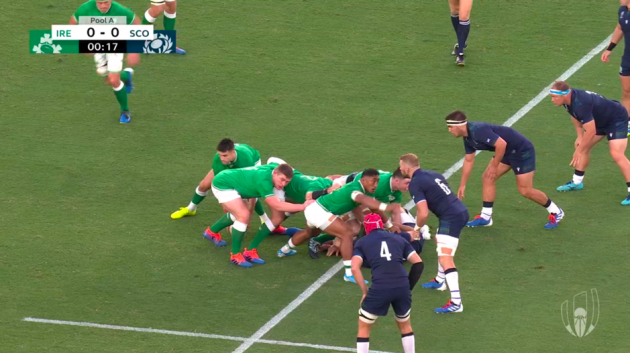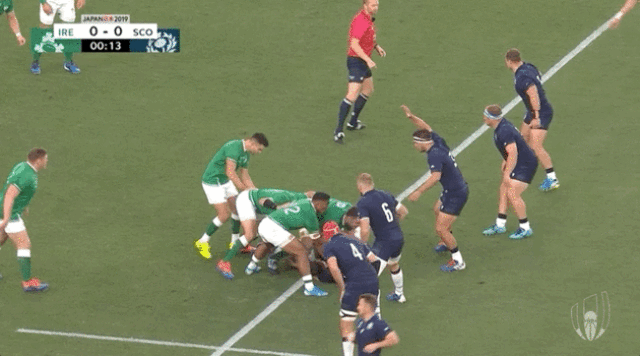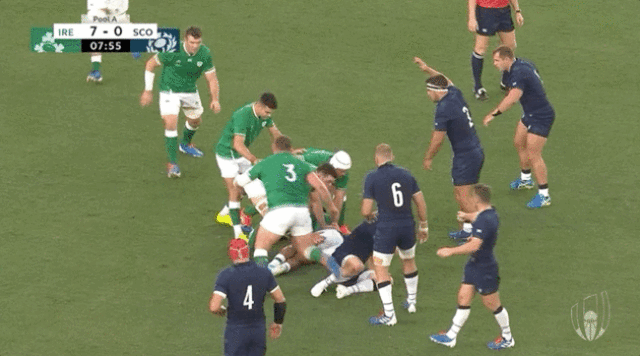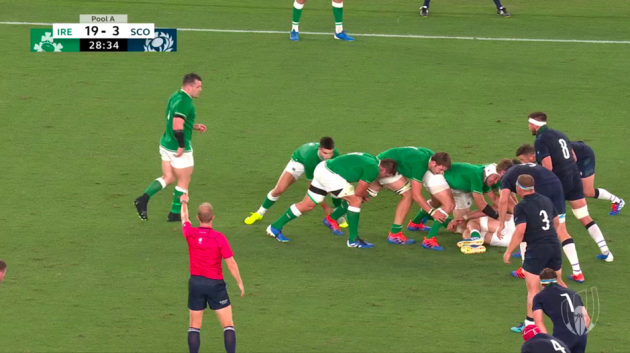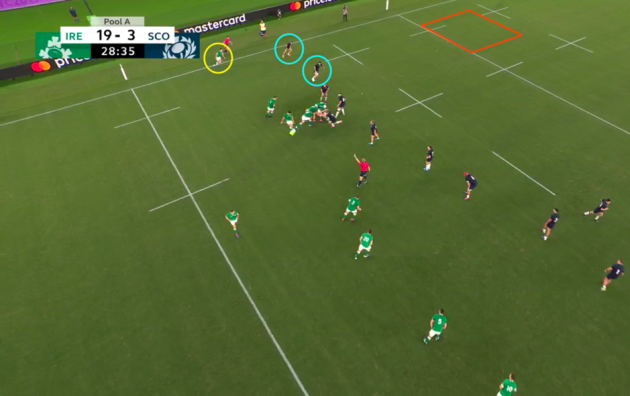IRELAND’S KICKING GAME was a key component to their bonus-point win over Scotland on the opening weekend of the Rugby World Cup.
Ireland put boot to ball a total of 36 times, the third-highest volume of any team in round one, with only Russia (42) and Tonga (39) kicking more often.
Weather conditions in the second half in Yokohama influenced proceedings and dictated that field position through the kicking game was necessary, but it is both the technical and tactical approach to how Ireland kicked that merits further analysis.
Conor Murray was unquestionably Ireland’s most influential player in their biggest winning margin over Scotland since 2015. 14 of the team’s kicks came through Murray’s right boot. The Munster playmaker provided Ireland with territorial advantage through enormous exit kicking and facilitated aerial pressure for his wingers with high hanging box kicks.
Indeed, four of Murray’s kicks were regathered by Ireland, one of which crucially lead to Andrew Conway’s second-half try, whilst Murray’s clever chip and chase deep off a lineout maul applied pressure on Scotland, ultimately resulting in the opening try of the match.
In the latest episode of The42 Rugby Weekly, we discussed how Scotland’s strategy early in the game to kick 50-metre restarts long to Ireland’s right-hand side was surprising, given that this would be the ideal side for the right-footed Murray to exit from.
Prior to the game, the general consensus was that Scotland’s best chance to beat Ireland was with a chaotic and unstructured performance, but this restart strategy was conventional and gave Ireland and Murray a relatively comfortable first entry point into the game.
There are three interesting aspects to Murray’s opening box kick to discuss.
1. Ruck Length
When building a platform from which to box kick, the first critical component is to add length to the breakdown. This provides separation from the kicker and opposition defenders, who must come from the back foot of the ruck when attempting to apply pressure to the kick.
In the image below, the front of the breakdown is solid with Peter O’Mahony and Bundee Aki alert to any Scottish counter-ruck potential.
Rory Best is bound onto both O’Mahony and Aki with his shoulders and brings both feet back to add length to the ruck.
Finally, Tadgh Furlong attaches himself to the right side of the breakdown to provide added protection for the right-footed Murray.
Arguably, Furlong could add further length with a more exaggerated split stance in this instance, but the Irish scrum-half is happy that it is a strong foundation to kick from.
2. Blockers
Depending on their kicking competency, some scrum-halves like to have the added security of a blocker when box kicking.
This player will stand adjacent to the ruck, generally a metre to a-metre-and-a-half, on the side the scrum-half is going to kick from. Legally the blocker must be in line with the hindmost foot of his side’s breakdown but does not have to be bound to the ruck.
He can stand in a stationary position but must not change lane to interfere with any defensive pressure. The detail on the blocker’s separation from the breakdown is important. When a scrum-half goes to kick, he will generally step back and across towards the side he is kicking to, so in order for the blocker to protect his scrum-half’s kicking foot from the opposition, he must not be too close or too far from the ruck.
Before revisiting Murray’s opening box kick, below is an image of Faf De Klerk using Malcolm Marx as a blocker in last weekend’s game against New Zealand.
Marx is potentially a little tight to the ruck but his starting position at the hindmost foot is accurate. An important detail from a defensive perspective is where the kick pressure should come from.
In the example above, we can see Aaron Smith is loaded as first defender off the ruck to rush De Klerk’s kick, however as I mentioned earlier, the kicking halfback will often step back and across to the side he is kicking to, which means Smith needs to start a touch wider or the second defender from the ruck – Ryan Crotty in this case – is the optimal player to go after the kicking foot, especially if the blocker is too close to the breakdown.
Going back to our image from Murray’s first kick, below, you can see that there is no blocker set for the Irish scrum-half.
This is consistent with all of Murray’s kicks from this game, whether they be clearing or contestable kicks. As one of the best kicking scrum-halves in world rugby, the additional protection of a blocker is not required.
Murray’s confidence in his ability is underpinned by the consistent speed at which he executes his kicking routine. From a sample set of his kicks last weekend, the time from when he picks the ball from the deck until his foot comes in contact with the ball is precisely 0.8 seconds. Having the ability to replicate his routine so accurately means Murray has the confidence to kick in a relatively unprotected environment.
Crucially, the implications of not having a blocker means that the trajectory on Murray’s clearance kicks can be flatter and therefore longer, which is reflected in this first kick of the game.
3. Kick Pressure
In the De Klerk example above, I briefly touched on the importance of how defenders position themselves when going to pressure the box kick. The first defender from a ruck plays a crucial role in any defensive system.
At a defensive ruck, the ‘one’ defender needs to be vigilant of any pick and go through the ruck – note this is a favourite play for teams like Samoa – as well as any running threat around the fringes from the attacking halfback.
Once the cues of a box kick are in motion – players adding length to the ruck, scrum-half slowing the ball down – then the ‘one’ defender can set a little wider but still with an eye on any potential threat around the fringe of the breakdown. The second defender, who is so important in setting the width in any defensive system, can afford to narrow up a touch when the box kick is being set up.
With no run option now available, he is the defender that is best placed to apply pressure to the kicking foot of the scrum-half, who is in effect stepping out towards him.
For Murray’s opening kick John Barclay is positioned as the first defender, with Grant Gilchrist as second defender. Having the second row in that kick pressure slot is best case scenario for obvious reason given his height and with no blocker for Murray, this is an ideal situation to rush the kicker in the opening seconds of Scotland’s biggest game in four years.
Inexplicably, no pressure is applied to Murray and the scrum-half peels off almost 30 metres to march back Scotland to the halfway line and get Ireland on the front foot immediately. Whilst only a small snapshot, this was symptomatic of the apathy Scotland showed in the opening 30 minutes of the game.
[Click here if you cannot view the clip above]
The above is an excellent illustration of a successful box kick from strong foundations with minimal opposition pressure.
Eight minutes later, with James Ryan having scored the first try of game, Scotland push repeat on the same restart strategy and kick long and left again to Ireland.
As we can see below, Conor Murray sets up to box kick again, however this time there is much-improved aggression and urgency from Scotland, which was so lacking in the opening minute. Stuart McInally targets his opposite number Best who is in a split stance – not advisable – at the front of the breakdown.
[Click here if you cannot view the clip above]
A key point here is that it is the responsibility of the players behind Best to add length to the breakdown, not Best himself who must provide a solid platform at the front of the ruck along with Ryan. Whilst Ryan is in a relatively good position having latched onto ball carrier Aki, Barclay reacts to his hooker’s counter-ruck and impressively shifts Ryan and Furlong off their feet.
Critically, this now denies Ireland of length at the breakdown with the arriving O’Mahony having to bind onto Furlong, who is on the ground. With five players now in the ruck, Ireland can ill afford to add more numbers as it would compromise the chase line.
Having disrupted the breakdown Scotland now have centre Duncan Taylor and Gilchrist in first and second defensive positions and both show good animation and energy to apply kick pressure to Murray.
Inferior halfbacks would definitely be vulnerable to a charge down in this situation with a lack of length to the breakdown, no blocker and two defenders on kick pressure, however the consistency of Murray’s kick routine enables to get his kick away but this time the pressure does affect both the angle and trajectory of his kick which fails to find touch and provides Stuart Hogg with a counter-attack opportunity.
Small details like this, which are so important against a world-class kicker like Murray, were inconsistent in Scotland’s performance and that will have frustrated Gregor Townsend.
Contestable Box Kicks
Whilst Murray’s exiting was crucial in ensuring Ireland won the territorial battle in Yokahama, the accuracy of his contestable box kicking then caused Scotland’s back three difficulties in the air which allowed Ireland another entry point into the game.
In addition to what has already been detailed, the critical components to a successful contestable box kick are both the accuracy of the kick and the role of the chaser.
Distance and hang time
The fundamentals of a contestable kick off scrum-half remain the same from a breakdown perspective. A solid base to the ruck with players adding length is still important to allow the halfback time and separation from opposition pressure to execute the kick.
The primary difference is the trajectory of the kick. Optimal distance for a contestable box kick is somewhere between 20 to 25 metres with a hang time of approximately four seconds to allow chasing players the best opportunity to contest for the ball.
We will take a look at two of Murray’s contestable kicks from the weekend to assess these components.
Chase and dealing with opposition interference
“A kick is only as good as it’s chase”
The chaser, often the winger, is critical to the successful outcome of any kick. Through hours of training together, the winger builds an understanding of his halfback’s kicking habits and cues, an essential connection so that the timing of the chase can be mastered. The most important aspect is that the chaser is at full pace and crossing the onside mark as the halfback strikes the ball.
I’m not implying that Andrew Conway knows it takes Murray 0.8 seconds to get to a kick but through repetition and, crucially, a consistent routine from the scrum-half means there can be a synergy between the two.
‘Fine margins’ is a term often used in elite sport and it is most definitely true in this aspect of the game where every millisecond counts.
The second significant consideration for the chaser is the opposition. ‘Escorting’ is a common tactic used by retreating players to influence the chasing player’s running line and allow protection for their own catcher.
Providing the escort does not change his running line, he is entitled to run back in a direct line to the dropping ball. However, there are numerous examples of opposition players clearly ‘changing lanes’ to obstruct the chaser and going unpunished. This makes it difficult for the chaser who is trying to sight the ball whilst running at full pace and once a body gets in his way, then the visual is often compromised and with it any chance of regaining possession.
Another tactic certain teams employ is for the retreating players to form a wall in front of the catcher. They are less concerned with the chaser in this instance and more preoccupied with where the ball is going to land and setting a barrier just in front of their catcher. This is something that Scotland looked to do against Ireland without a great deal of success.
Example one is from the first half. The ruck below is in pretty good shape with Best and Ringrose providing stability at the front, and Iain Henderson and CJ Stander adding length. Jacob Stockdale’s feet are at the top of the picture as primary chaser, with Cian Healy coming around as a second chaser.
The red rectangle below represents the optimal landing zone for Murray, with Stockdale circled in yellow as the chaser and the two Scottish players circled in blue who will look to provide catcher Finn Russell (out of shot) with protection.
Murray executes a perfectly-placed kick approximately 20 metres upfield with a hang time of 3.7 seconds.
The clip below illustrates Scotland’s Duncan Taylor and Tommy Seymour attempting to create a wall in front of Russell, but Stockdale does exceptionally well to push through Taylor and create a legal contest in the air for possession which he wins back and crucially Healy, as the secondary chaser picks up the bouncing ball.
[Click here if you cannot view the clip above]
A potential area of concern for Ireland is Stockdale’s push on Taylor. It is difficult for the Ulster winger as he wants to gain access to the catcher and effectively the retreating player is in front of the ball, but the push on Taylor has caused him to fall into Scottish jumper (Russell) in the air and potentially could have been penalised.
Example two is the kick which leads to Conway’s second-half try. The optimal land zone for Murray here would be just outside the 22m to take away the possibility of a mark if Scotland are to catch.
The Scottish retreat players are highlighted in blue below with Conway as the primary chaser in yellow.
Murray’s kick is again accurate, landing just inside the 22, travelling a total distance of 23 metres and achieving an incredible hang time of 4.2 seconds.
Crucially, Sean Maitland does not work back hard to provide protection for catcher Ryan Wilson which allows Conway an opportunity to contest for the ball.
[Click here if you cannot view the clip above]
Reserve Fraser Brown does impede Jordan Larmour and the Irishman pushes the retreating player in the back in an attempt to access the catcher, with Brown luckily falling into Conway rather than the jumper.
Wilson knocks on after a fair contest in the air with Conway, and Larmour pounces on the loose ball.
Conway does exceptionally well to get back to his feet and reload to his feet where the peerless Murray finds his Munster team-mate from the resulting ruck for Ireland’s bonus point try.
- Originally published at 10.13

